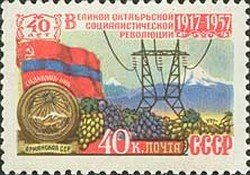Stamp: 40th Anniv. of Great October Revolution - Armenian SSR (Soviet Union, USSR 1957)
40th Anniv. of Great October Revolution - Armenian SSR (Soviet Union, USSR 1957)
25 October (Soviet Union, USSR ) within release Anniversaries goes into circulation Stamp 40th Anniv. of Great October Revolution - Armenian SSR face value 40 Russian kopek
| Stamp 40th Anniv. of Great October Revolution - Armenian SSR in catalogues | |
|---|---|
| Michel: | Mi:SU 2002 |
Stamp is horizontal format.
Also in the issue Anniversaries:
- Stamp - 40th Anniv. of Great October Revolution - Russian SSR face value 40;
- Stamp - 40th Anniv. of Great October Revolution - Kirghiz SSR face value 40;
- Stamp - 40th Anniv. of Great October Revolution - Armenian SSR face value 40;
- Stamp - 40th Anniv. of Great October Revolution - Moldavian SSR face value 40;
- Stamp - Byelorussian SSR, Truck face value 40;
- Stamp - 40th Anniv. of Great October Revolution - Tajik SSR face value 40;
- Stamp - 40th Anniv. of Great October Revolution - Latvian SSR face value 40;
- Stamp - 40th Anniv. of Great October Revolution - Kazakh SSR face value 40;
- Stamp - 40th Anniv. of Great October Revolution - Turkmen SSR face value 40;
- Stamp - 40th Anniv. of Great October Revolution - Azerbaijani SSR face value 40;
- Stamp - 40th Anniv. of Great October Revolution - Georgian SSR face value 40;
- Stamp - 40th Anniv. of Great October Revolution - Lithuanian SSR face value 40;
- Stamp - 40th Anniv. of Great October Revolution - Uzbek SSR face value 40;
- Stamp - 40th Anniv. of Great October Revolution - Estonian SSR face value 40;
Stamp 40th Anniv. of Great October Revolution - Armenian SSR it reflects the thematic directions:
A flag is a piece of fabric (most often rectangular or quadrilateral) with a distinctive design that is used as a symbol, as a signaling device, or as decoration. The term flag is also used to refer to the graphic design employed, and flags have since evolved into a general tool for rudimentary signalling and identification, especially in environments where communication is similarly challenging (such as the maritime environment where semaphore is used). National flags are patriotic symbols with varied wide-ranging interpretations, often including strong military associations due to their original and ongoing military uses. Flags are also used in messaging, advertising, or for other decorative purposes. The study of flags is known as vexillology, from the Latin word vexillum, meaning flag or banner.
Agriculture is the cultivation and breeding of animals, plants and fungi for food, fiber, biofuel, medicinal plants and other products used to sustain and enhance human life.[1] Agriculture was the key development in the rise of sedentary human civilization, whereby farming of domesticated species created food surpluses that nurtured the development of civilization. The study of agriculture is known as agricultural science. The history of agriculture dates back thousands of years, and its development has been driven and defined by greatly different climates, cultures, and technologies. Industrial agriculture based on large-scale monoculture farming has become the dominant agricultural methodology.
Electricity is the set of physical phenomena associated with the presence and motion of matter possessing an electric charge. Electricity is related to magnetism, both being part of the phenomenon of electromagnetism, as described by Maxwell's equations. Common phenomena are related to electricity, including lightning, static electricity, electric heating, electric discharges and many others.
A coat of arms is an heraldic visual design on an escutcheon (i.e. shield), surcoat, or tabard. The coat of arms on an escutcheon forms the central element of the full heraldic achievement which in its whole consists of shield, supporters, crest, and motto. A coat of arms is traditionally unique to an individual person, family (except in the United Kingdom), state, organisation or corporation.
An anniversary is the date on which an event took place or an institution was founded in a previous year, and may also refer to the commemoration or celebration of that event. For example, the first event is the initial occurrence or, if planned, the inaugural of the event. One year later would be the first anniversary of that event. The word was first used for Catholic feasts to commemorate saints. Most countries celebrate national anniversaries, typically called national days. These could be the date of independence of the nation or the adoption of a new constitution or form of government. The important dates in a sitting monarch's reign may also be commemorated, an event often referred to as a "Jubilee".





